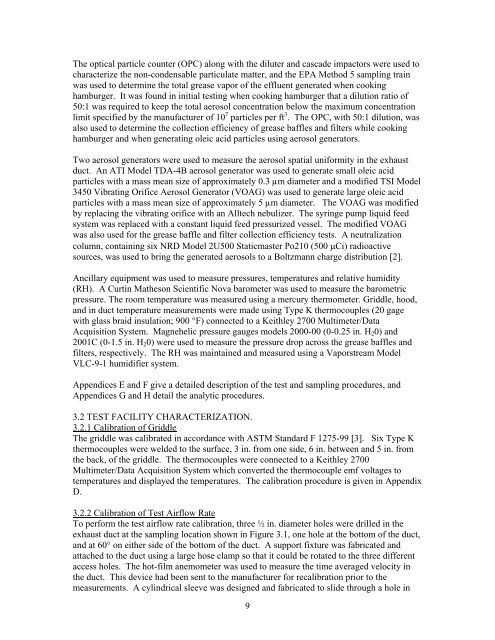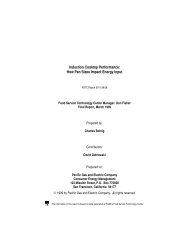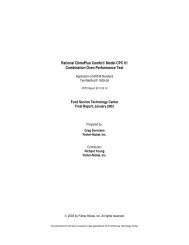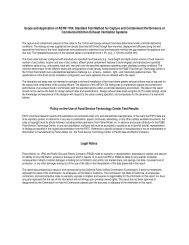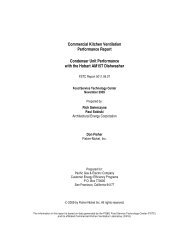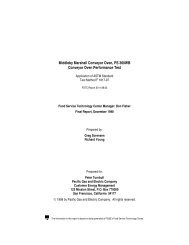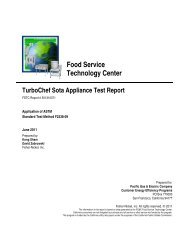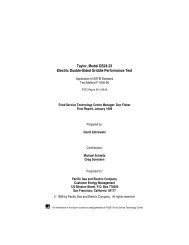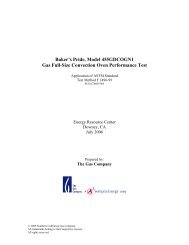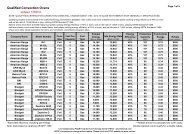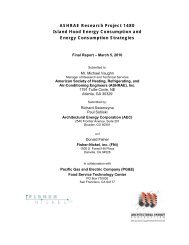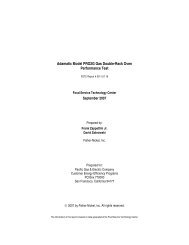Grease Filter Efficiency Test Method - Food Service Technology ...
Grease Filter Efficiency Test Method - Food Service Technology ...
Grease Filter Efficiency Test Method - Food Service Technology ...
Create successful ePaper yourself
Turn your PDF publications into a flip-book with our unique Google optimized e-Paper software.
The optical particle counter (OPC) along with the diluter and cascade impactors were used to<br />
characterize the non-condensable particulate matter, and the EPA <strong>Method</strong> 5 sampling train<br />
was used to determine the total grease vapor of the effluent generated when cooking<br />
hamburger. It was found in initial testing when cooking hamburger that a dilution ratio of<br />
50:1 was required to keep the total aerosol concentration below the maximum concentration<br />
limit specified by the manufacturer of 10 7 particles per ft 3 . The OPC, with 50:1 dilution, was<br />
also used to determine the collection efficiency of grease baffles and filters while cooking<br />
hamburger and when generating oleic acid particles using aerosol generators.<br />
Two aerosol generators were used to measure the aerosol spatial uniformity in the exhaust<br />
duct. An ATI Model TDA-4B aerosol generator was used to generate small oleic acid<br />
particles with a mass mean size of approximately 0.3 µm diameter and a modified TSI Model<br />
3450 Vibrating Orifice Aerosol Generator (VOAG) was used to generate large oleic acid<br />
particles with a mass mean size of approximately 5 µm diameter. The VOAG was modified<br />
by replacing the vibrating orifice with an Alltech nebulizer. The syringe pump liquid feed<br />
system was replaced with a constant liquid feed pressurized vessel. The modified VOAG<br />
was also used for the grease baffle and filter collection efficiency tests. A neutralization<br />
column, containing six NRD Model 2U500 Staticmaster Po210 (500 µCi) radioactive<br />
sources, was used to bring the generated aerosols to a Boltzmann charge distribution [2].<br />
Ancillary equipment was used to measure pressures, temperatures and relative humidity<br />
(RH). A Curtin Matheson Scientific Nova barometer was used to measure the barometric<br />
pressure. The room temperature was measured using a mercury thermometer. Griddle, hood,<br />
and in duct temperature measurements were made using Type K thermocouples (20 gage<br />
with glass braid insulation; 900 °F) connected to a Keithley 2700 Multimeter/Data<br />
Acquisition System. Magnehelic pressure gauges models 2000-00 (0-0.25 in. H 2 0) and<br />
2001C (0-1.5 in. H 2 0) were used to measure the pressure drop across the grease baffles and<br />
filters, respectively. The RH was maintained and measured using a Vaporstream Model<br />
VLC-9-1 humidifier system.<br />
Appendices E and F give a detailed description of the test and sampling procedures, and<br />
Appendices G and H detail the analytic procedures.<br />
3.2 TEST FACILITY CHARACTERIZATION.<br />
3.2.1 Calibration of Griddle<br />
The griddle was calibrated in accordance with ASTM Standard F 1275-99 [3]. Six Type K<br />
thermocouples were welded to the surface, 3 in. from one side, 6 in. between and 5 in. from<br />
the back, of the griddle. The thermocouples were connected to a Keithley 2700<br />
Multimeter/Data Acquisition System which converted the thermocouple emf voltages to<br />
temperatures and displayed the temperatures. The calibration procedure is given in Appendix<br />
D.<br />
3.2.2 Calibration of <strong>Test</strong> Airflow Rate<br />
To perform the test airflow rate calibration, three ½ in. diameter holes were drilled in the<br />
exhaust duct at the sampling location shown in Figure 3.1, one hole at the bottom of the duct,<br />
and at 60° on either side of the bottom of the duct. A support fixture was fabricated and<br />
attached to the duct using a large hose clamp so that it could be rotated to the three different<br />
access holes. The hot-film anemometer was used to measure the time averaged velocity in<br />
the duct. This device had been sent to the manufacturer for recalibration prior to the<br />
measurements. A cylindrical sleeve was designed and fabricated to slide through a hole in<br />
9


